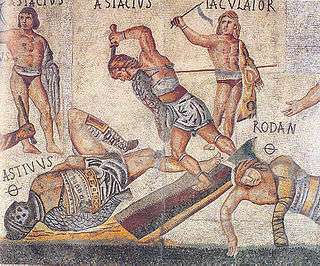Gladiator Mosaic

Detail of the Gladiator Mosaic.
Not to be confused with the "Mosaic of the Gladiators" from the Villa Dar Buc Ammera near Leptis Magna.
The Gladiator Mosaic is a famous mosaic of gladiators, dated to the first half of the 4th century. It was discovered in 1834 on the Borghese estate at Torrenova, on the Via Casilina outside Rome. It was one of the antiquities which reinvigorated the Borghese collection after it had shrunk following the sale of much of the collection to Napoleon I.
The name of each gladiator depicted is given in inscription next to the figure, with a Ø symbol (possibly the Greek letter Θ, for θάνατος "dead") marking the names of gladiators who died in combat. The inscription is listed as CIL VI 10206. A total of 33 names was on the mosaic, some of them now illegible.
- Licentiosus/ [------]// Purpureus/ Entinus/ Baccibus// Astacius// Astacius/ Astivus ∅ // Iaculator// [------]/ Rodan[---] ∅ // Melitio// Talamonius/ Aureus ∅ // Cupido ∅ / Bellerefons// [------]/ Pampineus// PI[---]// Arius// Eliacer// Melea[ger(?)]/ [------]// [---]us vic(it)// Mazicinus/ Alumnus vic(it)// Ideus r(e)t(iarius)// Callimorfus/ Mazicinus// [---]us vic(it)/ Callimorfus// Serpeneus// Sabatius
References
| Wikimedia Commons has media related to Gladiator Mosaic (Rome). |
This article is issued from Wikipedia - version of the 1/20/2016. The text is available under the Creative Commons Attribution/Share Alike but additional terms may apply for the media files.